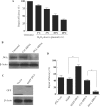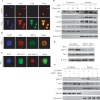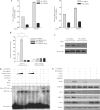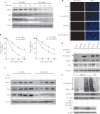JWA regulates XRCC1 and functions as a novel base excision repair protein in oxidative-stress-induced DNA single-strand breaks
- PMID: 19208635
- PMCID: PMC2665235
- DOI: 10.1093/nar/gkp054
JWA regulates XRCC1 and functions as a novel base excision repair protein in oxidative-stress-induced DNA single-strand breaks
Abstract
JWA was recently demonstrated to be involved in cellular responses to environmental stress including oxidative stress. Although it was found that JWA protected cells from reactive oxygen species-induced DNA damage, upregulated base excision repair (BER) protein XRCC1 and downregulated PARP-1, the molecular mechanism of JWA in regulating the repair of DNA single-strand breaks (SSBs) is still unclear. Our present studies demonstrated that a reduction in JWA protein levels in cells resulted in a decrease of SSB repair capacity and hypersensitivity to DNA-damaging agents such as methyl methanesulfonate and hydrogen peroxide. JWA functioned as a repair protein by multi-interaction with XRCC1. On the one hand, JWA was translocated into the nucleus by the carrier protein XRCC1 and co-localized with XRCC1 foci after oxidative DNA damage. On the other hand, JWA via MAPK signaling pathway regulated nuclear factor E2F1, which further transcriptionally regulated XRCC1. In addition, JWA protected XRCC1 protein from ubiquitination and degradation by proteasome. These findings indicate that JWA may serve as a novel regulator of XRCC1 in the BER protein complex to facilitate the repair of DNA SSBs.
Figures







Similar articles
-
JWA reverses cisplatin resistance via the CK2-XRCC1 pathway in human gastric cancer cells.Cell Death Dis. 2014 Dec 4;5(12):e1551. doi: 10.1038/cddis.2014.517. Cell Death Dis. 2014. PMID: 25476899 Free PMC article.
-
Distinct spatiotemporal patterns and PARP dependence of XRCC1 recruitment to single-strand break and base excision repair.Nucleic Acids Res. 2013 Mar 1;41(5):3115-29. doi: 10.1093/nar/gkt025. Epub 2013 Jan 25. Nucleic Acids Res. 2013. PMID: 23355608 Free PMC article.
-
E2F1 regulates the base excision repair gene XRCC1 and promotes DNA repair.J Biol Chem. 2008 May 30;283(22):15381-9. doi: 10.1074/jbc.M710296200. Epub 2008 Mar 17. J Biol Chem. 2008. PMID: 18348985 Free PMC article.
-
XRCC1 and DNA polymerase beta in cellular protection against cytotoxic DNA single-strand breaks.Cell Res. 2008 Jan;18(1):48-63. doi: 10.1038/cr.2008.7. Cell Res. 2008. PMID: 18166976 Free PMC article. Review.
-
X-ray repair cross complementing protein 1 in base excision repair.Int J Mol Sci. 2012 Dec 17;13(12):17210-29. doi: 10.3390/ijms131217210. Int J Mol Sci. 2012. PMID: 23247283 Free PMC article. Review.
Cited by
-
Jwa participates the maintenance of intestinal epithelial homeostasis via ERK/FBXW7-mediated NOTCH1/PPARγ/STAT5 axis and acts as a novel putative aging related gene.Int J Biol Sci. 2022 Aug 29;18(14):5503-5521. doi: 10.7150/ijbs.72751. eCollection 2022. Int J Biol Sci. 2022. PMID: 36147468 Free PMC article.
-
High FAK combined with low JWA expression: clinical prognostic and predictive role for adjuvant fluorouracil-leucovorin-oxaliplatin treatment in resectable gastric cancer patients.J Gastroenterol. 2013 Sep;48(9):1034-44. doi: 10.1007/s00535-012-0724-7. Epub 2013 Jan 11. J Gastroenterol. 2013. PMID: 23307041
-
SIRT1 deacetylated and stabilized XRCC1 to promote chemoresistance in lung cancer.Cell Death Dis. 2019 May 1;10(5):363. doi: 10.1038/s41419-019-1592-3. Cell Death Dis. 2019. PMID: 31043584 Free PMC article.
-
Astrocytic JWA expression is essential to dopaminergic neuron survival in the pathogenesis of Parkinson's disease.CNS Neurosci Ther. 2014 Aug;20(8):754-62. doi: 10.1111/cns.12249. Epub 2014 Mar 17. CNS Neurosci Ther. 2014. PMID: 24628733 Free PMC article.
-
JAC1 suppresses proliferation of breast cancer through the JWA/p38/SMURF1/HER2 signaling.Cell Death Discov. 2021 Apr 19;7(1):85. doi: 10.1038/s41420-021-00426-y. Cell Death Discov. 2021. PMID: 33875644 Free PMC article.
References
-
- Lindahl T. Instability and decay of the primary structure of DNA. Nature. 1993;362:709–715. - PubMed
-
- Caldecott KW. Mammalian DNA single-strand break repair: an X-ra(y)ted affair. Bioessays. 2001;23:447–455. - PubMed
-
- Xu YJ, Kim EY, Demple B. Excision of C-4'-oxidized deoxyribose lesions from double-stranded DNA by human apurinic/apyrimidinic endonuclease (Ape1 protein) and DNA polymerase beta. J. Biol. Chem. 1998;273:28837–28844. - PubMed
-
- Carrano AV, Minkler JL, Dillehay LE, Thompson LH. Incorporated bromodeoxyuridine enhances the sister-chromatid exchange and chromosomal aberration frequencies in an EMS-sensitive Chinese hamster cell line. Mutat. Res. 1986;162:233–239. - PubMed
-
- Dominguez I, Daza P, Natarajan AT, Cortes F. A high yield of translocations parallels the high yield of sister chromatid exchanges in the CHO mutant EM9. Mutat. Res. 1998;398:67–73. - PubMed
Publication types
MeSH terms
Substances
LinkOut - more resources
Full Text Sources
Other Literature Sources
Molecular Biology Databases
Miscellaneous

